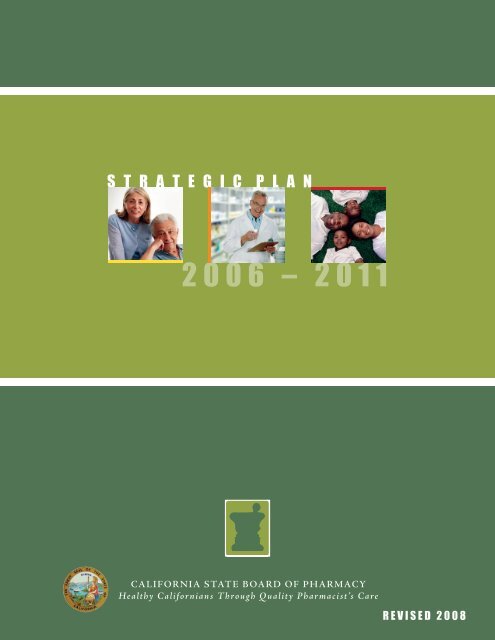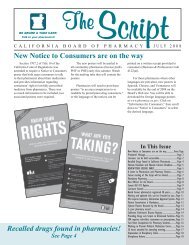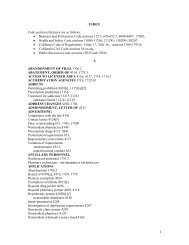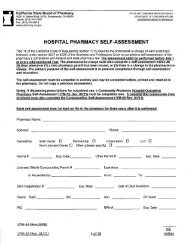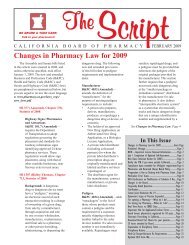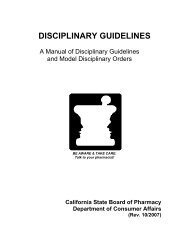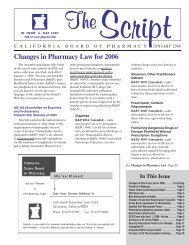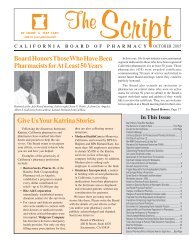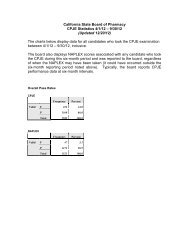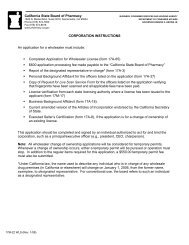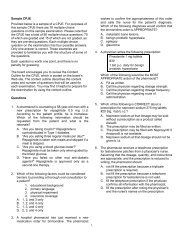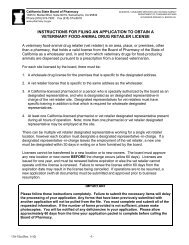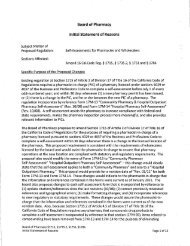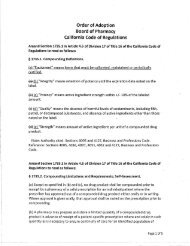Strategic Plan - Board of Pharmacy
Strategic Plan - Board of Pharmacy
Strategic Plan - Board of Pharmacy
You also want an ePaper? Increase the reach of your titles
YUMPU automatically turns print PDFs into web optimized ePapers that Google loves.
S T R A T E G I C<br />
P L A N<br />
2 0 0 6 – 2 0 1 1<br />
CALIFORNIA STATE BOARD OF PHARMACY<br />
Healthy Californians Through Q uality Pharmacist ’s Care<br />
R E V I S E D 2 0 0 8
<strong>Strategic</strong> <strong>Plan</strong><br />
California State <strong>Board</strong> <strong>of</strong> <strong>Pharmacy</strong><br />
2 0 0 6<br />
—<br />
2 0 1 1<br />
Members:<br />
Kenneth Schell, Pharm.D., Pharmacist Member, President<br />
D. Timothy Dazé Esq., Public Member, Vice President<br />
Stanley C . Weisser, Pharmacist Member, Treasurer<br />
Ryan Brooks, Public Member<br />
James Burg ard , Public Member<br />
Robert Graul, Pharmacist Member<br />
William Powers , Public Member<br />
Susan Ravnan, Pharm.D., Pharmacist Member<br />
Robert Swart , Pharm.D., Pharmacist Member<br />
Shirley Wheat , Public Member<br />
Andrea Zinder, Public Member<br />
Virginia Herold , Executive Officer<br />
California State <strong>Board</strong> <strong>of</strong> Pharmac y<br />
1625 N. Market Boulevard , N-219<br />
Sacramento, CA 95834<br />
(916) 574-7900<br />
www.pharmac y.ca .gov<br />
Revised November 2008
T A B L E O F C O N T E N T S<br />
President ’s Message . . . . . . . . . . . . . . . . . . . . . . . . . . . . . . . . . . . . . . . . . . . 4<br />
Vision and Mission Statements . . . . . . . . . . . . . . . . . . . . . . . . . . . . . . . . . . . 5<br />
Agenc y Description – About the <strong>Board</strong> <strong>of</strong> Pharmac y . . . . . . . . . . . . . . . . . . . . 5<br />
<strong>Strategic</strong> Issues To Be Addressed . . . . . . . . . . . . . . . . . . . . . . . . . . . . . . . . . 6<br />
Summary <strong>of</strong> Goals . . . . . . . . . . . . . . . . . . . . . . . . . . . . . . . . . . . . . . . . . . . . 10<br />
Goals and Related Objec tives , Measures , Tasks and Resource Assumptions . . . 11<br />
Goal Alignment Matrix to Objec tives . . . . . . . . . . . . . . . . . . . . . . . . . . . . . . 19<br />
S canning Assessment and Methodology . . . . . . . . . . . . . . . . . . . . . . . . . . . . . 20<br />
Shared Values/Core Principles . . . . . . . . . . . . . . . . . . . . . . . . . . . . . . . . . . . 21<br />
Internal/External Assessment . . . . . . . . . . . . . . . . . . . . . . . . . . . . . . . . . . . . 21
President’s Message<br />
The strategic planning process <strong>of</strong> the California State <strong>Board</strong> <strong>of</strong><br />
<strong>Pharmacy</strong> is an annual effort <strong>of</strong> the board members, staff and the<br />
public to anticipate and plan for events and issues for the coming<br />
year. Although the board considers its current strategic plan when<br />
going through the planning exercise, the board also attempts to<br />
predict upcoming changes in pharmacy practice, consumer needs<br />
and demands and health care trends. After a lengthy discussion <strong>of</strong><br />
potential and existing issues, the participants go through a process<br />
to categorize, consolidate and finally prioritize the issues and then<br />
set the goals for the coming year. The resulting strategic plan<br />
keeps the board focused on established goals while allowing the<br />
flexibility <strong>of</strong> handling new questions and challenges as they arise.<br />
Each board committee considers its individual strategic plan goals<br />
at every meeting and the progress on the goals are reviewed at each<br />
<strong>of</strong> the quarterly full board meetings. The careful planning and<br />
continuous monitoring <strong>of</strong> the strategic plan assures that the board<br />
achieves its stated objectives and performs with optimal efficiency.<br />
The board publishes advance notice for each strategic planning<br />
meeting and encourages participation and contribution by all<br />
interested citizens <strong>of</strong> California who attend. Involvement <strong>of</strong> the<br />
board, its staff and the public results in a strategic plan that truly<br />
represents the public interest and serves the consumers <strong>of</strong> this<br />
state.
CALIFORNIA STATE BOARD OF PHARMACY<br />
VISION STATEMENT<br />
Healthy Californians through quality pharmacist’s care.<br />
MISSION STATEMENT<br />
The <strong>Board</strong> <strong>of</strong> <strong>Pharmacy</strong> protects and promotes the<br />
health and safety <strong>of</strong> Californians by pursuing the<br />
highest quality <strong>of</strong> pharmacist’s care and the<br />
appropriate use <strong>of</strong> pharmaceuticals through<br />
education, communication, licensing, legislation,<br />
regulation, and enforcement.<br />
ABOUT THE CALIFORNIA STATE BOARD OF PHARMACY<br />
The California State <strong>Board</strong> <strong>of</strong> <strong>Pharmacy</strong> (board) was established in 1891 to protect consumers<br />
by licensing and regulating those responsible for dispensing medications to the public. Today<br />
the board oversees all aspects <strong>of</strong> the practice <strong>of</strong> pharmacy in California: the practitioner (the<br />
pharmacists), the practice site (the pharmacies), and the product (drugs and devices). Additionally<br />
the board regulates drug wholesalers and other practitioners and specialized facilities. With<br />
an annual budget <strong>of</strong> nearly $9.7 million and a staff <strong>of</strong> over 50, the board licenses over 100,000<br />
individuals and firms, and enforces 12 complex and varied regulatory programs.<br />
The board has five policy development committees to fulfill its charge. The five committees are:<br />
Enforcement, Communication and Public Education, Licensing, Legislation and Regulation, and<br />
Organizational Development. Each <strong>of</strong> these committees corresponds to a mission-related goal.<br />
The board supports an active Web site,<br />
www.pharmacy.ca.gov, that provides consumer<br />
education material, application material for<br />
licensing and information for ensuring compliance<br />
with California <strong>Pharmacy</strong> Law . The Web site also<br />
provides times and information on board meetings<br />
as well as other critical forums vital to pharmacy<br />
services were public comments and input are<br />
sought and encouraged.
STRATEGIC ISSUES TO BE ADDRESSED<br />
1. Cost <strong>of</strong> medical/pharmaceutical care<br />
Providing necessar y medication for all Californians is a concern; there is an<br />
increasing demand for affordable health care ser vices. Also, spiraling medical care<br />
and prescription drug costs may influence people to tak e shor t cuts on their drug<br />
therapy or to seek medications from nontraditional pharmac y sources. Tiered<br />
pricing is a global realit y. Due to global communication, patients can access<br />
drugs at different prices, worldwide. Patients seek lower cost medications from<br />
these sources because patients assume that prescription drugs are <strong>of</strong> the same<br />
qualit y as they are accustomed to obtaining from their neighborhood pharmacies.<br />
However, the cost <strong>of</strong> drugs drives unscrupulous individuals (such as counter feiters<br />
and diver ters) as well as conscientious health care providers to operate in this<br />
marketplace, the former endanger public health and confidence in the prescription<br />
drugs patients tak e.<br />
2. Aging population<br />
3. Pharmacists’ ability to provide care<br />
There are increasingly more senior citizens, and that population<br />
is living longer. Aging consumers <strong>of</strong>ten have decreased<br />
cognitive sk ills, eyesight and mobilit y. Consequently as the<br />
senior population increases so will the volume <strong>of</strong> prescriptions<br />
and the impac t on pharmacists and pharmac y personnel to<br />
meet the demand. Specialized training <strong>of</strong> pharmacists may be<br />
necessar y to better ser ve the needs <strong>of</strong> aging patients.<br />
Many senior citizens, who previously may not have had<br />
prescription drug insurance coverage, will benefit from the new<br />
prescription drug benefit <strong>of</strong> Medicare that star ted in Januar y<br />
2006. However, this new benefit has been implemented with<br />
significant problems for some seniors, and as a complicated new<br />
program, will require public education and perhaps statutor y<br />
modification.<br />
The abilit y <strong>of</strong> pharmac y to provide optimal care for patients with chronic conditions<br />
is being challenged. Drugs are becoming more power ful and it is anticipated that<br />
more inter vention by pharmacists will be required. The challenge is even greater<br />
when consumers fill multiple prescriptions at different pharmacies. The pharmacist<br />
shor tage, increased consumer demand for prescription drugs, patient compliance<br />
in tak ing medications and polypharmac y are issues which will impac t pharmacists’<br />
abilit y to provide care.
4. Changing demographics <strong>of</strong> California patients<br />
The diversit y <strong>of</strong> California’s population is growing with<br />
respec t to race, ethnicit y and linguistic sk ills, as is the<br />
segment that seeks drugs and produc ts from foreign<br />
countries. This requires greater k nowledge, understanding<br />
and sk ills from health care prac titioners. The increasing<br />
diversit y <strong>of</strong> patients is coupled with culturally-based beliefs that under value the<br />
need for licensed pharmacists and pharmacies, and instead encourage purchase <strong>of</strong><br />
prescription drugs from nontraditional locations and providers.<br />
There also is widespread belief that there must be a medication solution for ever y<br />
condition or disease state.<br />
5. Laws governing pharmacists<br />
New laws enhancing pharmacists’ roles as health care providers are needed. The<br />
laws must address several k ey issues including: expansion <strong>of</strong> the scope <strong>of</strong> pharmac y<br />
prac tice, the ratio <strong>of</strong> personnel overseen by pharmacists, delineation <strong>of</strong> the role<br />
<strong>of</strong> pharmacists relative to selling versus nonselling duties <strong>of</strong> personnel, and the<br />
responsibilit y for legal and regulator y compliance <strong>of</strong> the pharmacist-in- charge.<br />
6. I ntegrity <strong>of</strong> the drug deliver y system<br />
I mplementation <strong>of</strong> the e -pedigree for prescription drugs will reduce the growing<br />
incidence <strong>of</strong> counter feit, damaged, adulterated or misbranded medications in<br />
California’s pharmacies. Additionally the federal government has demonstrated an<br />
increasing interest in regulating health care to safeguard consumer interests. New<br />
legislation and regulation may be created in response to emergenc y preparedness,<br />
disaster response and pandemics. Changes in the prescription drug benefits<br />
provided to Medicare beneficiaries will continue to command attention.<br />
7. Technology Adaptation<br />
Technology will greatly impac t the processing and dispensing <strong>of</strong> medication.<br />
Elec tronic prescribing and “channeling” to locations other than a traditional<br />
pharmac y may become the business model Automated pharmac y systems and<br />
elec tronic prescribing will impac t pharmac y. New methods <strong>of</strong> dispensing<br />
medications raise additional liabilit y issues. New medication, perhaps<br />
engineered for specific patients, will become available at high costs and<br />
require special patient monitoring systems.
8. I nternet issues<br />
The availabilit y <strong>of</strong> prescription drugs over the I nternet is on the rise. Multiple<br />
and easy access <strong>of</strong> drugs without pharmacist par ticipation is dangerous. Entities<br />
promoting illegal drug distribution schemes have tak en advantage <strong>of</strong> the I nternet.<br />
Monitoring and protec ting the public from improper drug distribution from these<br />
I nternet pharmacies is severely impaired with continued resource constraints by<br />
both the federal and state agencies with jurisdic tion.<br />
9. Disaster planning and response<br />
Pharmacists need to be ready to be positioned to<br />
provide emergenc y care and medication in response to<br />
natural disasters, pandemics and terrorism. This requires<br />
specialized k nowledge, advance planning and integration<br />
<strong>of</strong> local, state and federal resources that can be quick ly<br />
mobilized. Specialized drug distribution channels will<br />
need to be authorized to permit emergenc y response.<br />
Additionally, regulator y adjustments to the September 11<br />
terrorism may affec t persons’ rights to privac y.<br />
10. Q ualified staff and <strong>Board</strong> Members<br />
The state’s fiscal crisis has affec ted the board’s abilit y to investigate customer<br />
complaints or hire staff. The board lost 20 percent <strong>of</strong> its staff positions during the<br />
prior five years due to the state’s hiring freezes. Loss <strong>of</strong> these staff has altered the<br />
provision <strong>of</strong> ser vices by the board. The salar y disparit y bet ween the private and<br />
public sec tors in compensation for pharmacists will mak e it difficult to recruit and<br />
retain pharmacist inspec tors. Moreover, for all staff, if wages remain essentially<br />
frozen, the retention <strong>of</strong> current employees could be impac ted.<br />
The diversit y and involvement <strong>of</strong> all board members in polic y development is<br />
impor tant for public health and protec tion. At least a quorum <strong>of</strong> board members is<br />
needed to ensure the board can mak e decisions and ac t timely.<br />
11. Pharmac y/health care in the 21st centur y<br />
The state’s health care prac titioners (pharmacists, physicians, nurses) are being<br />
influenced by a variet y <strong>of</strong> internal and ex ternal fac tors that affec t and will continue<br />
to effec t health care provided to patients. I mproved patient care will result from<br />
improved integration among these pr<strong>of</strong>essions. Also, a renewed emphasis on<br />
patient consultation will benefit patient k nowledge about their drug therapy and<br />
thus improve their care.
12. I nformation Management<br />
Creation, maintenance and transfer <strong>of</strong> elec tronic patient records and prescription<br />
orders will be the norm in the future. Patient records need to remain confidential<br />
and secured from unauthorized access. Pharmacies and wholesalers need to ensure<br />
the availabilit y <strong>of</strong> an e -pedigree for drugs obtained, transferred and dispensed. I t is<br />
lik ely that all controlled drugs dispensed in California will be track ed elec tronically<br />
by the CURES system.<br />
Patient records need to<br />
remain confidential and<br />
secured from unauthorized<br />
access. Pharmacies and<br />
wholesalers need to ensure<br />
the availability <strong>of</strong> an<br />
e -pedigree for drugs<br />
obtained, transferred and<br />
dispensed.
Summary <strong>of</strong> Goals<br />
Goal One<br />
Exercise oversight on all pharmacy activities.<br />
Goal Two<br />
Ensure the qualifications <strong>of</strong> licensees.<br />
Goal Three<br />
Advocate legislation and promulgate regulations that<br />
advance the vision and mission <strong>of</strong> the <strong>Board</strong> <strong>of</strong> <strong>Pharmacy</strong>.<br />
Goal Four<br />
Provide relevant information to consumers and licensees.<br />
Goal Five<br />
Achieve the board’s mission and goals.<br />
10
GOALS, OUTCOMES, OBJECTIVES, AND MEASURES<br />
ENFORCEMENT COMMITTEE<br />
Goal 1:<br />
Outcome:<br />
Exercise oversight on all pharmacy activities.<br />
Improve consumer protection.<br />
Objective 1.1<br />
Achieve 100 percent closure or referral on all cases within 6 months by June 30, 2011:<br />
Measure:<br />
Percentage <strong>of</strong> cases closed or referred within 6 months<br />
Tasks: 1. Mediate all consumer complaints within 90 days.<br />
2. Investigate all other cases within 120 days.<br />
3. Close (e.g. issue citation and fine, refer to the AG’s Office) all board investigations and<br />
mediations within 180 days.<br />
Objective 1.2<br />
Manage enforcement activities for achievement <strong>of</strong> performance expectations<br />
Measure:<br />
Percentage compliance with program requirements<br />
Tasks: 1. Administer the Pharmacists Recovery Program.<br />
2. Administer the probation monitoring program.<br />
3. Issue citations and fines within 30 days<br />
4. Issue letters <strong>of</strong> admonition within 30 days<br />
5. Obtain immediate public protection sanctions for egregious violations.<br />
6. Pursue petitions to revoke probation within 90 days for noncompliance with<br />
probationary conditions.<br />
Objective 1.3<br />
Measure:<br />
Achieve 100 percent closure on all administrative cases within one year by June 30, 2011.<br />
Percentage closure <strong>of</strong> administrative cases within 1 year<br />
Objective 1.4<br />
Inspect 100 percent <strong>of</strong> all licensed facilities once every 3 years by June 30, 2011.<br />
Measure:<br />
Percentage <strong>of</strong> licensed facilities inspected once every 3 years<br />
Tasks: 1. Inspect licensed premises to educate licensees proactively about legal requirements and<br />
practice standards to prevent serious violations that could harm the public.<br />
2. Inspect sterile compounding pharmacies annually before renewal or before initial<br />
licensure.<br />
3. Initiate investigations based upon violations discovered during routine inspections.<br />
11
Objective 1.5<br />
Initiate policy review <strong>of</strong> 25 emerging enforcement issues by June 30, 2011<br />
Measure:<br />
The number <strong>of</strong> issues<br />
Tasks: 1. Monitor the implementation <strong>of</strong> e-pedigree on all prescription medications sold in<br />
California<br />
2. Implement federal restrictions on ephedrine, pseudoephedrine or phenylpropanolamine<br />
products<br />
3. Monitor the efforts <strong>of</strong> the DEA and DHHS to implement electronic prescribing for<br />
controlled substances.<br />
4. Evaluate establishment <strong>of</strong> an ethics course as an enforcement option.<br />
5. Participate in emerging issues <strong>of</strong> the national level affecting the health <strong>of</strong> Californians<br />
regarding their prescription medicine.<br />
12
LICENSING COMMITTEE<br />
Goal 2:<br />
Outcome:<br />
Ensure the qualifications <strong>of</strong> licensees.<br />
Qualified licensees<br />
Objective 2.1<br />
Issue licenses within three working days <strong>of</strong> a completed application by June 30, 2011.<br />
Measure:<br />
Percentage <strong>of</strong> licenses issued within 3 work days<br />
Tasks: 1. Review 100 percent <strong>of</strong> all applications within 7 work days <strong>of</strong> receipt.<br />
2. Process 100 percent <strong>of</strong> all deficiency documents within 5 work days <strong>of</strong> receipt.<br />
3. Make a licensing decision within 3 work days after all deficiencies are corrected.<br />
4. Issue pr<strong>of</strong>essional and occupational licenses to those individuals and firms that meet<br />
minimum requirements.<br />
· Pharmacists<br />
· Intern pharmacists<br />
· <strong>Pharmacy</strong> technicians<br />
· Pharmacies<br />
· Non-resident pharmacies<br />
· Wholesaler drug facilities<br />
· Veterinary food animal drug retailers<br />
· Designated Representatives (the non-pharmacists who may operate sites other<br />
than pharmacies)<br />
· Out-<strong>of</strong>-state distributors<br />
· Clinics<br />
· Hypodermic needle and syringe distributors<br />
5. Withdraw applications <strong>of</strong> applicants not meeting board requirements or where the<br />
application has been abandoned.<br />
6. Deny applications to those who do not meet California standards.<br />
Objective 2.2<br />
Cashier 100 percent <strong>of</strong> all application and renewal fees within two working days <strong>of</strong> receipt<br />
by June 30, 2011.<br />
Measure:<br />
Percentage <strong>of</strong> cashiered application and renewal fees within 2 working days<br />
Tasks: 1. Cashier application fees.<br />
2. Cashier renewal fees<br />
3. Secure online renewal <strong>of</strong> licenses<br />
13
Objective 2.3<br />
Update 100 percent <strong>of</strong> all information changes to licensing records within 5 working days<br />
by June 30, 2011.<br />
Measure:<br />
Percentage <strong>of</strong> licensing records changes within 5 working days<br />
Tasks: 1. Make address and name changes.<br />
2. Process discontinuance <strong>of</strong> businesses forms and related components.<br />
3. Process changes in pharmacist-in-charge and designated representative-in-charge.<br />
4. Process <strong>of</strong>f-site storage applications.<br />
5. Transfer <strong>of</strong> intern hours to other states<br />
Objective 2.4<br />
Implement at least 25 changes to improve licensing decisions by June 30, 2011.<br />
Measure:<br />
Number <strong>of</strong> implemented changes<br />
Tasks: 1. Determine why 26 states do not allow the use <strong>of</strong> a CA license as the basis for transfer a<br />
pharmacist license to that state.<br />
2. Work with the University <strong>of</strong> California to evaluate the drug distribution system <strong>of</strong> its<br />
clinics and their appropriate licensure.<br />
3. Work with the Department <strong>of</strong> Corrections on the licensure <strong>of</strong> pharmacies in prisons.<br />
4. Work with local and state <strong>of</strong>ficials on emergency preparedness and planning for<br />
pandemic and disasters. <strong>Plan</strong>ning to include the storage and distribution <strong>of</strong> drugs to as<br />
sure patient access and safety.<br />
5. Evaluate the need to issue a provisional license to pharmacy technician trainees.<br />
6. Evaluate use <strong>of</strong> a second pharmacy technician certification examination (ExCPT ) as a<br />
possible qualifying route for registration <strong>of</strong> technicians.<br />
7. Implement the Department <strong>of</strong> Consumer Affairs Applicant Tracking System to facilitate<br />
implementation <strong>of</strong> I-Licensing system, allowing online renewal <strong>of</strong> licenses by 2008.<br />
8. Participate with California’s Schools <strong>of</strong> <strong>Pharmacy</strong> in reviewing basic level experiences<br />
required <strong>of</strong> intern pharmacists, in accordance with new ACPE standards.<br />
9. Implement new test administration requirements for the CPJE.<br />
14
LEGISLATION AND REGULATION COMMITTEE<br />
Goal 3:<br />
Outcome:<br />
Advocate legislation and promulgate regulations that advance the vision and<br />
mission <strong>of</strong> the <strong>Board</strong> <strong>of</strong> <strong>Pharmacy</strong>.<br />
Improve the health and safety <strong>of</strong> Californians.<br />
Objective 3.1<br />
Annually identify and respond with legislative changes to keep pharmacy laws current and<br />
consistent with the board’s mission.<br />
Measure:<br />
100 percent successful enactment <strong>of</strong> promoted legislative changes<br />
Tasks: 1. Secure extension <strong>of</strong> board’s sunset date (SB 1476).<br />
2. Sponsor legislation to update pharmacy law (SB 1475).<br />
3. Advocate the board’s role and its positions regarding pharmacists’ care and dispensing <strong>of</strong><br />
dangerous drugs and devices (AB 2408).<br />
4. Secure statutory standards for pharmacies that compound medications (AB 595)<br />
5. Secure implementation <strong>of</strong> e-pedigrees on prescription drugs dispensed in California<br />
(SB 1476)<br />
Objective 3.2<br />
Annually identify and respond with regulatory changes to keep pharmacy regulations<br />
current and consistent with the board’s mission.<br />
Measure:<br />
Percentage successful enactment <strong>of</strong> promoted regulatory changes<br />
Tasks: 1. Authorize technicians to check technicians in inpatient pharmacies with clinical<br />
pharmacist programs (sections 1793.7-1793.8).<br />
2. Authorize the use <strong>of</strong> prescription drop boxes and automated delivery machines for<br />
outpatient pharmacies (sections 1713 and 1717(e))<br />
3. Make technical changes in pharmacy regulations to keep the code updated<br />
Section 1706.2 criteria for abandonment <strong>of</strong> files<br />
Section 1775.4 contested citations<br />
Section 1709.1 designation <strong>of</strong> pharmacist-in-charge<br />
Section 1780 standards for wholesalers<br />
Section 1780.1 standards for veterinary food animal drug retailers<br />
Section 1781 Designated Representative certificate<br />
Section 1786 Designated Representative<br />
4. Notice <strong>of</strong> posting regarding electronic files (section 1717.2)<br />
5. Disciplinary guidelines revision and update (section 1760)<br />
6. Self-assessment <strong>of</strong> a wholesaler by the designated representative section (1784)<br />
7. Exempt the address <strong>of</strong> records <strong>of</strong> interns from display on the board’s Web site<br />
(section 1727.1)<br />
8. Modification <strong>of</strong> building standards for pharmacies – rulemaking by the California<br />
Building Standards Commission<br />
9. Update Notice to Consumers Poster in conformance with AB 2583 (Chapter 487, Statutes<br />
2006)(Section 1707.2)<br />
15
Objective 3.3<br />
Measure:<br />
Tasks:<br />
Review 5 areas <strong>of</strong> pharmacy law for relevancy, currency and value for consumer protection<br />
by June 30, 2011.<br />
Number <strong>of</strong> areas <strong>of</strong> pharmacy law reviewed<br />
16
COMMUNICATION AND PUBLIC EDUCATION COMMITTEE<br />
Goal 4:<br />
Outcome:<br />
Provide relevant information to consumers and licensees.<br />
Improved consumer awareness and licensee knowledge.<br />
Objective 4.1<br />
Develop a minimum <strong>of</strong> 10 communication venues to the public by June 30, 2011.<br />
Measure:<br />
Number <strong>of</strong> communication venues developed to the public<br />
Tasks: 1. Assess the effectiveness <strong>of</strong> the board’s educational materials and outreach: survey<br />
consumers to identify whether board-produced materials are valued and what new<br />
materials are desired.<br />
2. Restructure the board’s Web site to make it more user friendly.<br />
3. Work with the California Health Communication Partnership on integrated public<br />
information campaigns on health-care topics.<br />
4. Continue collaboration with UCSF’s Center for Consumer Self Care for pharmacist interns<br />
to develop consumer fact sheets on health topics.<br />
5. Develop a Notice to Consumers to comply with requirements <strong>of</strong> SB 2583 (Nation) on<br />
patients’ rights to secure legitimately prescribed medication from pharmacies.<br />
6. Evaluate the practice <strong>of</strong> pill splitting as a consumer protection issue.<br />
7. Evaluate the SCR 49 Medication Errors Report for implementation.<br />
Objective 4.2<br />
Develop 10 communication venues to licensees by June 30, 2011.<br />
Measure:<br />
Number <strong>of</strong> communication venues developed to licensees<br />
Tasks: 1. Publish The Script two times annually.<br />
2. Develop board-sponsored continuing education programs in pharmacy law and<br />
coordinate presentation at local and annual pr<strong>of</strong>essional association meetings<br />
throughout California.<br />
3. Maintain important and timely licensee information on Web site.<br />
Objective 4.3<br />
Participate in 12 forums, conferences and public education events annually<br />
Measure:<br />
Number <strong>of</strong> forums participated<br />
Tasks: 1. Participate in forums, conferences and educational fairs.<br />
17
ORGANIZATIONAL DEVELOPMENT COMMITTEE<br />
Goal 5:<br />
Outcome:<br />
Achieve the board’s mission and goals.<br />
An effective organization<br />
Objective 5.1<br />
Obtain 100 percent approval for identified program needs by June 30, 2011.<br />
Measure:<br />
Percentage approved for identified program needs<br />
Tasks: 1. Review workload and resources to streamline operations, target backlogs and maximize<br />
services.<br />
2. Develop budget change proposals to secure funding for needed resources.<br />
3. Perform strategic management <strong>of</strong> the board through all committees and board activities.<br />
4. Manage the board’s financial resources to ensure fiscal viability and program integrity.<br />
Objective 5.2<br />
Maintain 100 percent staffing <strong>of</strong> all board positions.<br />
Measure:<br />
Percentage staffing <strong>of</strong> board positions<br />
Tasks: 1. Continue active recruitment <strong>of</strong> pharmacists for inspector positions.<br />
2. Vigorously recruit for any vacant positions.<br />
3. Perform annual performance and training assessments <strong>of</strong> all staff.<br />
Objective 5.3<br />
Measure:<br />
Tasks:<br />
Succession planning and workforce retention.<br />
Secure enhanced training <strong>of</strong> staff to improve job pr<strong>of</strong>iciency<br />
Objective 5.4<br />
Implement 10 strategic initiatives to automate board processes by June 30, 2011.<br />
Measure:<br />
Number <strong>of</strong> strategic initiatives implemented to automate board processes<br />
Tasks: 1. Implement automated applicant tracking (ATS).<br />
2. Implement online license renewal and application submission features (I-Licensing).<br />
3. Integrate telephonic features to improve board services without adding staff resources.<br />
4. Use the department’s newly created “ad hoc” system to generate data for reports.<br />
Objective 5.5<br />
Provide for communication venues to communicate within the board by June 30, 2011.<br />
Measure:<br />
Number <strong>of</strong> communication venues to communicate within the board<br />
Tasks: 1. Continue the Communication Team to improve communication among staff and host<br />
biannual staff meetings.<br />
2. Continue Enforcement Team meetings with board members and enforcement staff.<br />
3. Convene annual inspector meetings to ensure standardized investigation and inspection<br />
processes, law and practice updates and earn continuing education credit.<br />
18
Objective 5.6<br />
Annually conduct at least 2 outreach programs where public policy issues on health care<br />
are being discussed.<br />
Measure:<br />
Number <strong>of</strong> outreach programs conducted in one year<br />
Tasks: 1. Convene the Subcommittee on Medicare Part D Implementation<br />
2. Convene the Workgroup to implement the e-Pedigree<br />
3. Host the National Association <strong>of</strong> <strong>Board</strong>s <strong>of</strong> <strong>Pharmacy</strong> District 7 and 8 Meeting in<br />
California<br />
4. Attend outreach programs.<br />
Objective 5.7<br />
Measure:<br />
Tasks:<br />
Perform succession planning to ensure continuity for board operations during staff<br />
retirements.<br />
Number <strong>of</strong> staff trained for advanced duties and promoted.<br />
Objective 5.8<br />
Respond to all public record requests within 10 days.<br />
Measure:<br />
Percentage response to public record requests within 10 days<br />
Tasks: 1. Respond to public records requests within 10 days (e.g., license verifications,<br />
investigative information, licensing information).<br />
2. Respond to subpoenas within the timeline specified.<br />
3. Respond to specific requests for data reports<br />
19
<strong>Strategic</strong> Issues<br />
Goal 1:<br />
Exercise<br />
oversight<br />
on all<br />
pharmacy<br />
activities<br />
Goal Alignment Matrix – <strong>Strategic</strong> Issues<br />
Goal 2:<br />
Ensure the<br />
qualifications<br />
<strong>of</strong><br />
licensees.<br />
Goal 3:<br />
Advocate<br />
legislation and<br />
promulgate<br />
regulations<br />
that advance<br />
the Vision and<br />
Mission <strong>of</strong> BOP.<br />
Goal 4:<br />
Provide<br />
relevant<br />
information<br />
to consumers<br />
and<br />
licensees.<br />
Goal 5:<br />
Achieve<br />
the<br />
<strong>Board</strong>’s<br />
Mission<br />
and<br />
Goals.<br />
1. Cost <strong>of</strong> medical/<br />
pharma-ceutical care X X X X<br />
2. Aging population X X X X<br />
3. Pharmacists’ ability<br />
to provide care X X X X X<br />
4. Changing<br />
demographics <strong>of</strong> CA<br />
patients<br />
X X X X X<br />
5. Laws governing<br />
pharmacists X X X X<br />
6. Integrity <strong>of</strong> the<br />
drug delivery system X X X<br />
7. Technology<br />
adaptation X X X X<br />
8. Internet Issues X X X<br />
9. Disaster planning<br />
and Response X X X X X<br />
10. Qualified staff X X X<br />
11. <strong>Pharmacy</strong>/<br />
Healthcare<br />
Integration in the<br />
21st century<br />
X X X X X<br />
12. Information<br />
Management X X X X X<br />
20
SCANNING ASSESSMENT AND METHODOLOGY<br />
I n assessing the critical data that will influence the<br />
board’s abilit y to fulfill its vision and mission, the strategic<br />
planning team completed several scanning ac tivities<br />
in 2006. <strong>Board</strong> members, all staff and stak eholders<br />
par ticipated in completing a sur vey questionnaire<br />
that was submitted to the strategic planning team for<br />
synthesis and analysis. This included review <strong>of</strong> the board’s<br />
mission, vision, goals and strategic issues. Additionally<br />
a “SWOT ” analysis (an acronym for strengths, weak nesses,<br />
oppor tunities and threats) was conduc ted during the<br />
sur vey as par t <strong>of</strong> the scanning assessment.<br />
I n developing its strategic plan, the board relied upon<br />
the full par ticipation <strong>of</strong> its entire staff, its board members<br />
and its interested stak eholders. The par ticipation <strong>of</strong> each<br />
group has provided impor tant information necessar y for<br />
a dynamic strategic plan, capable <strong>of</strong> guiding the board in<br />
fulfilling its mission for several years.<br />
I n developing its<br />
strategic plan, the<br />
board relied upon<br />
the full par ticipation<br />
<strong>of</strong> its entire staff,<br />
its board members<br />
and its interested<br />
stakeholders.<br />
After each group per formed the SWOT analyses described<br />
above, the board refined the strategic issues to be<br />
addressed during the April 2006 Meeting, and the results<br />
are summarized in this plan under “<strong>Strategic</strong> Issues to be<br />
Addressed.”<br />
Additional refinement <strong>of</strong> board objec tives and ac tivities<br />
was conduc ted during late spring 2006 by each <strong>of</strong> the<br />
board’s strategic committees, and the final strategic plan<br />
for 2006-11 was approved at the July 2006 <strong>Board</strong> Meeting.<br />
21
SHARED VALUES/CORE PRINCIPLES<br />
The <strong>Board</strong> <strong>of</strong> Pharmac y will exhibit:<br />
· Vision<br />
· I ntegrit y<br />
· Flexibilit y<br />
· Commitment<br />
· Loyalt y to its mission<br />
· Relevance to impor tant issues<br />
· Compassion, and<br />
· Open-mindedness<br />
These values will be exhibited when considering all matters before the board affec ting<br />
the consumers <strong>of</strong> California and the pr<strong>of</strong>ession <strong>of</strong> pharmac y.<br />
INTERNAL/EXTERNAL ASSESSMENT<br />
The critical data stemming from the SWOT analysis is reflected below. The information represents<br />
a deliberative process <strong>of</strong> multiple iterations conducted with the board members, staff and<br />
stakeholders.<br />
Strengths<br />
1. Staff/Inspectors: Staff ’s teamwork, dedication, diversity,<br />
and knowledge. Pharmacist inspectors provide necessary,<br />
specialized knowledge.<br />
2. Leadership: Support and communication provided by<br />
management, diversity and experience <strong>of</strong> board members.<br />
Opportunities<br />
1. Pharmacist’s Role: <strong>Pharmacy</strong> pr<strong>of</strong>ession has large<br />
potential role in healthcare delivery. Pharmacists have<br />
opportunities in roles associated with patient care and not<br />
exclusively dispensing.<br />
2. Technology/Automation: Promoting legislation and<br />
regulations to foster the use <strong>of</strong> technological advances<br />
by pharmacies, attainment <strong>of</strong> operational efficiencies,<br />
decreased administrative burdens, and enhanced patient<br />
care services.<br />
3. Consumer Safety/Privacy: Promoting a nonpunitive<br />
learning environment approach to improving pharmacy<br />
patient safety. Continuing emphasis on patient safety by<br />
involving the pharmacist in patient care.<br />
Weaknesses<br />
1. Resources: Budget constraints and insufficient resources<br />
to meet mandated duties at desired levels<br />
2. Staffing Shortages: Insufficient staff to perform, manage,<br />
and review consumer protection activities <strong>of</strong> licensing,<br />
enforcement, and education programs.<br />
Threats<br />
1. <strong>Board</strong> <strong>of</strong> <strong>Pharmacy</strong> staffing is insufficient to perform<br />
mandated duties at desired levels.<br />
2. <strong>Board</strong> funding: Lack <strong>of</strong> funding for new programs; lack<br />
<strong>of</strong> fiscal control <strong>of</strong> board over much <strong>of</strong> its budget; budget<br />
constraints and deficits; hiring freeze.<br />
3. Cost <strong>of</strong> pharmaceuticals: Impacts <strong>of</strong> the increasing costs<br />
<strong>of</strong> pharmaceuticals cannot be managed or controlled by the<br />
consumer or the board.<br />
4. <strong>Pharmacy</strong> personnel shortage: Lack <strong>of</strong> licensees impedes<br />
the ability <strong>of</strong> patients to receive quality pharmacists care.<br />
4. Public education: Increasingly informed consumers means<br />
the pr<strong>of</strong>ession must be able to deliver public education on<br />
drug use safety and healthcare issues.<br />
22
Healthy Californians Through Q uality Pharmacist ’s Care<br />
S T R A T E G I C P L A N<br />
California State <strong>Board</strong> <strong>of</strong> <strong>Pharmacy</strong><br />
1625 North Market Blvd., Suite N-219<br />
Sacramento, CA 95834<br />
916 574.7900<br />
916 574.8618 fax<br />
www.pharmacy.ca.gov


